Salmon


Salmon /ˈsæmən/ is the common name for several species of ray-finned fish in the family Salmonidae. Other fish in the same family include trout, char, grayling and whitefish. Salmon are native to tributaries of the North Atlantic (genus Salmo) and Pacific Ocean (genus Oncorhynchus). Many species of salmon have been introduced into non-native environments such as the Great Lakes of North America and Patagonia in South America. Salmon are intensively farmed in many parts of the world.
Typically, salmon are anadromous: they are born in fresh water, migrate to the ocean, then return to fresh water to reproduce. However, populations of several species are restricted to fresh water through their lives. Various species of salmon display anadromous life strategies while others display freshwater resident life strategies. Folklore has it that the fish return to the exact spot where they were born to spawn; tracking studies have shown this to be mostly true. A portion of a returning salmon run may stray and spawn in different freshwater systems. The percent of straying depends on the species of salmon.[2] Homing behavior has been shown to depend on olfactory memory.[3][4]
Species
The term "salmon" comes from the Latin salmo, which in turn may have originated from salire, meaning "to leap".[5] The nine commercially important species of salmon occur in two genera. The genus Salmo contains the Atlantic salmon, found in the north Atlantic, as well as many species commonly named trout. The genus Oncorhynchus contains eight species which occur naturally only in the North Pacific. As a group, these are known as Pacific salmon. Chinook salmon have been introduced in New Zealand and Patagonia. Coho, freshwater sockeye, and Atlantic salmon have been established in Patagonia, as well.[6]
| This article is one of a series on |
| Commercial fish |
|---|
| |
| Large pelagic |
| billfish, bonito mackerel, salmon shark, tuna |
|
|
| Forage |
| anchovy, herring menhaden, sardine shad, sprat |
|
|
| Demersal |
| cod, eel, flatfish pollock, ray |
| Mixed |
| carp, tilapia |
| Atlantic and Pacific salmon | |||||||||||
|---|---|---|---|---|---|---|---|---|---|---|---|
| Genus | Common name | Scientific name | Maximum length |
Common length |
Maximum weight |
Maximum age |
Trophic level |
Fish Base |
FAO | ITIS | IUCN status |
| Salmo (Atlantic salmon) |
Atlantic salmon | Salmo salar Linnaeus, 1758 | 150 cm | 120 cm | 46.8 kg | 13 years | 4.4 | [7] | [8] | [9] | |
| Oncorhynchus (Pacific salmon) |
Chinook salmon | Oncorhynchus tshawytscha (Walbaum, 1792) | 150 cm | 70 cm | 61.4 kg | 9 years | 4.4 | [11] | [12] | [13] | Not assessed |
| Chum salmon | Oncorhynchus keta (Walbaum, 1792) | 100 cm | 58 cm | 15.9 kg | 7 years | 3.5 | [14] | [15] | [16] | Not assessed | |
| Coho salmon | Oncorhynchus kisutch (Walbaum, 1792) | 108 cm | 71 cm | 15.2 kg | 5 years | 4.2 | [17] | [18] | [19] | Not assessed | |
| Masu salmon | Oncorhynchus masou (Brevoort, 1856) | 79 cm | cm | 10.0 kg | 3 years | 3.6 | [20] | [21] | Not assessed | ||
| Pink salmon | Oncorhynchus gorbuscha (Walbaum, 1792) | 76 cm | 50 cm | 6.8 kg | 3 years | 4.2 | [22] | [23] | [24] | Not assessed | |
| Sockeye salmon | Oncorhynchus nerka (Walbaum, 1792) | 84 cm | 58 cm | 7.7 kg | 8 years | 3.7 | [25] | [26] | [27] | | |
† Both the Salmo and Oncorhynchus genera also contain a number of species referred to as trout. Within Salmo, additional minor taxa have been called salmon in English, i.e. the Adriatic salmon (Salmo obtusirostris) and Black Sea salmon (Salmo labrax). The steelhead anadromous form of the rainbow trout migrates to sea, but it is not termed "salmon".
Also a number of other species have common names which refer to them as being salmon. Of those listed below, the Danube salmon or huchen is a large freshwater salmonid related to the salmon above, but others are marine fishes of the unrelated Perciformes order:
| Some other fishes called salmon | ||||||||||
|---|---|---|---|---|---|---|---|---|---|---|
| Common name | Scientific name | Maximum length |
Common length |
Maximum weight |
Maximum age |
Trophic level |
Fish Base |
FAO | ITIS | IUCN status |
| Australian salmon | Arripis trutta (Forster, 1801) | 89 cm | 47 cm | 9.4 kg | 26 years | 4.1 | [29] | [30] | Not assessed | |
| Danube salmon | Hucho hucho (Linnaeus, 1758) | 150 cm | 70 cm | 52 kg | 15 years | 4.2 | [31] | [32] | | |
| Hawaiian salmon | Elagatis bipinnulata (Quoy & Gaimard, 1825) | 180 cm | 90 cm | 46.2 kg | years | 3.6 | [34] | [35] | [36] | Not assessed |
| Indian salmon | Eleutheronema tetradactylum (Shaw, 1804) | 200 cm | 50 cm | 145 kg | years | 4.4 | [37] | [38] | Not assessed | |
Eosalmo driftwoodensis, the oldest known salmon in the fossil record, helps scientists figure how the different species of salmon diverged from a common ancestor. The British Columbia salmon fossil provides evidence that the divergence between Pacific and Atlantic salmon had not yet occurred 40 million years ago. Both the fossil record and analysis of mitochondrial DNA suggest the divergence occurred by 10 to 20 million years ago. This independent evidence from DNA analysis and the fossil record rejects the glacial theory of salmon divergence.[39]
Distribution
.jpg)
- Atlantic salmon (Salmo salar) reproduce in northern rivers on both coasts of the Atlantic Ocean.
- Landlocked salmon (Salmo salar m. sebago) live in a number of lakes in eastern North America and in Northern Europe, for instance in lakes Sebago, Onega, Ladoga, Saimaa, Vänern, and Winnipesaukee. They are not a different species from the Atlantic salmon, but have independently evolved a non-migratory life cycle, which they maintain even when they could access the ocean.
- Chinook salmon (Oncorhynchus tshawytscha) are also known in the US as king salmon or blackmouth salmon, and as spring salmon in British Columbia. Chinook are the largest of all Pacific salmon, frequently exceeding 14 kg (30 lb).[40] The name tyee is used in British Columbia to refer to Chinook over 30 pounds, and in the Columbia River watershed, especially large Chinook were once referred to as June hogs. Chinook salmon are known to range as far north as the Mackenzie River and Kugluktuk in the central Canadian arctic,[41] and as far south as the Central California coast.[42]
- Chum salmon (Oncorhynchus keta) are known as dog, keta, or calico salmon in some parts of the US. This species has the widest geographic range of the Pacific species:[43] south to the Sacramento River in California in the eastern Pacific and the island of Kyūshū in the Sea of Japan in the western Pacific; north to the Mackenzie River in Canada in the east and to the Lena River in Siberia in the west.
- Coho salmon (Oncorhynchus kisutch) are also known in the US as silver salmon. This species is found throughout the coastal waters of Alaska and British Columbia and as far south as Central California (Monterey Bay).[44] It is also now known to occur, albeit infrequently, in the Mackenzie River.[41]
- Masu salmon or cherry salmon (Oncorhynchus masou) are found only in the western Pacific Ocean in Japan, Korea, and Russia. A land-locked subspecies known as the Taiwanese salmon or Formosan salmon (Oncorhynchus masou formosanus) is found in central Taiwan's Chi Chia Wan Stream.[45]
- Pink salmon (Oncorhynchus gorbuscha), known as humpies in southeast and southwest Alaska, are found from northern California and Korea, throughout the northern Pacific, and from the Mackenzie River[41] in Canada to the Lena River in Siberia, usually in shorter coastal streams. It is the smallest of the Pacific species, with an average weight of 1.6 to 1.8 kg (3.5 to 4.0 lb).[46]
- Sockeye salmon (Oncorhynchus nerka) are also known in the US as red salmon.[47] This lake-rearing species is found south as far as the Klamath River in California in the eastern Pacific and northern Hokkaidō island in Japan in the western Pacific and as far north as Bathurst Inlet in the Canadian Arctic in the east and the Anadyr River in Siberia in the west. Although most adult Pacific salmon feed on small fish, shrimp, and squid, sockeye feed on plankton they filter through gill rakers.[48] Kokanee salmon are the land-locked form of sockeye salmon.
- Danube salmon, or huchen (Hucho hucho), are the largest permanent freshwater salmonid species.
Life cycle


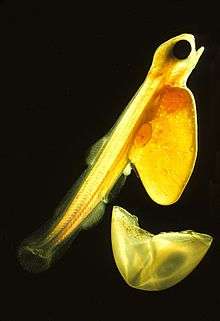
Salmon eggs are laid in freshwater streams typically at high latitudes. The eggs hatch into alevin or sac fry. The fry quickly develop into parr with camouflaging vertical stripes. The parr stay for six months to three years in their natal stream before becoming smolts, which are distinguished by their bright, silvery colour with scales that are easily rubbed off. Only 10% of all salmon eggs are estimated to survive to this stage.[49] The smolt body chemistry changes, allowing them to live in salt water. Smolts spend a portion of their out-migration time in brackish water, where their body chemistry becomes accustomed to osmoregulation in the ocean.
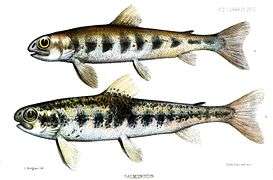
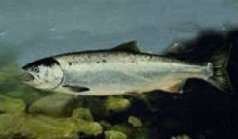


The salmon spend about one to five years (depending on the species) in the open ocean, where they gradually become sexually mature. The adult salmon then return primarily to their natal streams to spawn. Atlantic salmon spend between one and four years at sea. (When a fish returns after just one year's sea feeding, it is called a grilse in Canada, Britain, and Ireland.) Prior to spawning, depending on the species, salmon undergo changes. They may grow a hump, develop canine-like teeth, or develop a kype (a pronounced curvature of the jaws in male salmon). All change from the silvery blue of a fresh-run fish from the sea to a darker colour. Salmon can make amazing journeys, sometimes moving hundreds of miles upstream against strong currents and rapids to reproduce. Chinook and sockeye salmon from central Idaho, for example, travel over 1,400 km (900 mi) and climb nearly 2,100 m (7,000 ft) from the Pacific Ocean as they return to spawn. Condition tends to deteriorate the longer the fish remain in fresh water, and they then deteriorate further after they spawn, when they are known as kelts. In all species of Pacific salmon, the mature individuals die within a few days or weeks of spawning, a trait known as semelparity. Between 2 and 4% of Atlantic salmon kelts survive to spawn again, all females. However, even in those species of salmon that may survive to spawn more than once (iteroparity), postspawning mortality is quite high (perhaps as high as 40 to 50%.)
To lay her roe, the female salmon uses her tail (caudal fin), to create a low-pressure zone, lifting gravel to be swept downstream, excavating a shallow depression, called a redd. The redd may sometimes contain 5,000 eggs covering 2.8 m2 (30 sq ft).[50] The eggs usually range from orange to red. One or more males approach the female in her redd, depositing sperm, or milt, over the roe.[48] The female then covers the eggs by disturbing the gravel at the upstream edge of the depression before moving on to make another redd. The female may make as many as seven redds before her supply of eggs is exhausted.[48]
Each year, the fish experiences a period of rapid growth, often in summer, and one of slower growth, normally in winter. This results in ring formation around an earbone called the otolith, (annuli) analogous to the growth rings visible in a tree trunk. Freshwater growth shows as densely crowded rings, sea growth as widely spaced rings; spawning is marked by significant erosion as body mass is converted into eggs and milt.
Freshwater streams and estuaries provide important habitat for many salmon species. They feed on terrestrial and aquatic insects, amphipods, and other crustaceans while young, and primarily on other fish when older. Eggs are laid in deeper water with larger gravel, and need cool water and good water flow (to supply oxygen) to the developing embryos. Mortality of salmon in the early life stages is usually high due to natural predation and human-induced changes in habitat, such as siltation, high water temperatures, low oxygen concentration, loss of stream cover, and reductions in river flow. Estuaries and their associated wetlands provide vital nursery areas for the salmon prior to their departure to the open ocean. Wetlands not only help buffer the estuary from silt and pollutants, but also provide important feeding and hiding areas.
Salmon not killed by other means show greatly accelerated deterioration (phenoptosis, or "programmed aging") at the end of their lives. Their bodies rapidly deteriorate right after they spawn as a result of the release of massive amounts of corticosteroids.
Ecology
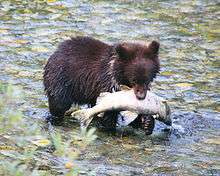
Bears and salmon
In the Pacific Northwest and Alaska, salmon are keystone species, supporting wildlife such as birds, bears and otters.[51] The bodies of salmon represent a transfer of nutrients from the ocean, rich in nitrogen, sulfur, carbon and phosphorus, to the forest ecosystem.
Grizzly bears function as ecosystem engineers, capturing salmon and carrying them into adjacent wooded areas. There they deposit nutrient-rich urine and feces and partially eaten carcasses. Bears are estimated to leave up to half the salmon they harvest on the forest floor,[52][53] in densities that can reach 4,000 kilograms per hectare,[54] providing as much as 24% of the total nitrogen available to the riparian woodlands. The foliage of spruce trees up to 500 m (1,600 ft) from a stream where grizzlies fish salmon have been found to contain nitrogen originating from fished salmon.[55]
Beavers and salmon
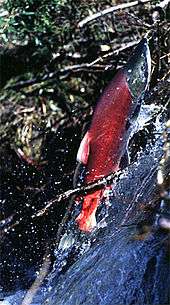
Beavers also function as ecosystem engineers; in the process of clear-cutting and damming, beavers alter their ecosystems extensively. Beaver ponds can provide critical habitat for juvenile salmon. An example of this was seen in the years following 1818 in the Columbia River Basin. In 1818, the British government made an agreement with the U.S. government to allow U.S. citizens access to the Columbia catchment (see Treaty of 1818). At the time, the Hudson's Bay Company sent word to trappers to extirpate all furbearers from the area in an effort to make the area less attractive to U.S. fur traders. In response to the elimination of beavers from large parts of the river system, salmon runs plummeted, even in the absence of many of the factors usually associated with the demise of salmon runs. Salmon recruitment can be affected by beavers' dams because dams can:[56][57][58]
- Slow the rate at which nutrients are flushed from the system; nutrients provided by adult salmon dying throughout the fall and winter remain available in the spring to newly hatched juveniles
- Provide deeper water pools where young salmon can avoid avian predators
- Increase productivity through photosynthesis and by enhancing the conversion efficiency of the cellulose-powered detritus cycle
- Create low-energy environments where juvenile salmon put the food they ingest into growth rather than into fighting currents
- Increase structural complexity with many physical niches where salmon can avoid predators
Beavers' dams are able to nurture salmon juveniles in estuarine tidal marshes where the salinity is less than 10 ppm. Beavers build small dams of generally less than 60 cm (2 ft) high in channels in the myrtle zone. These dams can be overtopped at high tide and hold water at low tide. This provides refuges for juvenile salmon so they do not have to swim into large channels where they are subject to predation.[59]
Parasites
According to Canadian biologist Dorothy Kieser, the myxozoan parasite Henneguya salminicola is commonly found in the flesh of salmonids. It has been recorded in the field samples of salmon returning to the Haida Gwaii Islands. The fish responds by walling off the parasitic infection into a number of cysts that contain milky fluid. This fluid is an accumulation of a large number of parasites.
Henneguya and other parasites in the myxosporean group have complex life cycles, where the salmon is one of two hosts. The fish releases the spores after spawning. In the Henneguya case, the spores enter a second host, most likely an invertebrate, in the spawning stream. When juvenile salmon migrate to the Pacific Ocean, the second host releases a stage infective to salmon. The parasite is then carried in the salmon until the next spawning cycle. The myxosporean parasite that causes whirling disease in trout has a similar life cycle.[60] However, as opposed to whirling disease, the Henneguya infestation does not appear to cause disease in the host salmon — even heavily infected fish tend to return to spawn successfully.
According to Dr. Kieser, a lot of work on Henneguya salminicola was done by scientists at the Pacific Biological Station in Nanaimo in the mid-1980s, in particular, an overview report[61] which states, "the fish that have the longest fresh water residence time as juveniles have the most noticeable infections. Hence in order of prevalence coho are most infected followed by sockeye, chinook, chum and pink." As well, the report says, at the time the studies were conducted, stocks from the middle and upper reaches of large river systems in British Columbia such as Fraser, Skeena, Nass and from mainland coastal streams in the southern half of B.C., "are more likely to have a low prevalence of infection." The report also states, "It should be stressed that Henneguya, economically deleterious though it is, is harmless from the view of public health. It is strictly a fish parasite that cannot live in or affect warm blooded animals, including man".
According to Klaus Schallie, Molluscan Shellfish Program Specialist with the Canadian Food Inspection Agency, "Henneguya salminicola is found in southern B.C. also and in all species of salmon. I have previously examined smoked chum salmon sides that were riddled with cysts and some sockeye runs in Barkley Sound (southern B.C., west coast of Vancouver Island) are noted for their high incidence of infestation."
Sea lice, particularly Lepeophtheirus salmonis and various Caligus species, including C. clemensi and C. rogercresseyi, can cause deadly infestations of both farm-grown and wild salmon.[62][63] Sea lice are ectoparasites which feed on mucus, blood, and skin, and migrate and latch onto the skin of wild salmon during free-swimming, planktonic nauplii and copepodid larval stages, which can persist for several days.[64][65][66] Large numbers of highly populated, open-net salmon farms can create exceptionally large concentrations of sea lice; when exposed in river estuaries containing large numbers of open-net farms, many young wild salmon are infected, and do not survive as a result.[67][68] Adult salmon may survive otherwise critical numbers of sea lice, but small, thin-skinned juvenile salmon migrating to sea are highly vulnerable. On the Pacific coast of Canada, the louse-induced mortality of pink salmon in some regions is commonly over 80%.[69]
Wild fisheries

Commercial
As can be seen from the production chart at the left, the global capture reported by different countries to the FAO of commercial wild salmon has remained fairly steady since 1990 at about one million tonnes per year. This is in contrast to farmed salmon (below) which has increased in the same period from about 0.6 million tonnes to well over two million tonnes.[1]
Nearly all captured wild salmon are Pacific salmon. The capture of wild Atlantic salmon has always been relatively small, and has declined steadily since 1990. In 2011 only 2,500 tonnes were reported.[8] In contrast about half of all farmed salmon are Atlantic salmon.
Recreational
Recreational salmon fishing can be a technically demanding kind of sport fishing, not necessarily congenial for beginning fishermen.[70] A conflict exists between commercial fishermen and recreational fishermen for the right to salmon stock resources. Commercial fishing in estuaries and coastal areas is often restricted so enough salmon can return to their natal rivers where they can spawn and be available for sport fishing. On parts of the North American west coast sport salmon fishing completely replaces inshore commercial fishing.[71] The commercial value of a salmon can be several times less than the value of the same fish caught by a sport fisherman. This is "a powerful economic argument for allocating stock resources preferentially to sport fishing."[71]
Farmed salmon
Salmon aquaculture is a major contributor to the world production of farmed finfish, representing about US$10 billion annually. Other commonly cultured fish species include: tilapia, catfish, sea bass, carp and bream. Salmon farming is significant in Chile, Norway, Scotland, Canada and the Faroe Islands; it is the source for most salmon consumed in the United States and Europe. Atlantic salmon are also, in very small volumes, farmed in Russia and the island of Tasmania, Australia.
Salmon are carnivorous. They are fed a meal produced from catching other wild fish and other marine organisms. Salmon farming leads to a high demand for wild forage fish. Salmon require large nutritional intakes of protein, and farmed salmon consume more fish than they generate as a final product. To produce one pound of farmed salmon, products from several pounds of wild fish are fed to them. As the salmon farming industry expands, it requires more wild forage fish for feed, at a time when 75% of the world's monitored fisheries are already near to or have exceeded their maximum sustainable yield.[72] The industrial-scale extraction of wild forage fish for salmon farming affects the survivability of the wild predator fish which rely on them for food.
Work continues on substituting vegetable proteins for animal proteins in the salmon diet. This substitution results in lower levels of the highly valued omega-3 fatty acid content in the farmed product.
Intensive salmon farming uses open-net cages, which have low production costs. It has the drawback of allowing disease and sea lice to spread to local wild salmon stocks.[73]
On a dry weight basis, 2–4 kg of wild-caught fish are needed to produce one kg of salmon.[74]

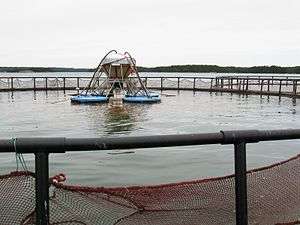
Another form of salmon production, which is safer but less controllable, is to raise salmon in hatcheries until they are old enough to become independent. They are released into rivers in an attempt to increase the salmon population. This system is referred to as ranching. It was very common in countries such as Sweden, before the Norwegians developed salmon farming, but is seldom done by private companies. As anyone may catch the salmon when they return to spawn, a company is limited in benefiting financially from their investment.
Because of this, the ranching method has mainly been used by various public authorities and nonprofit groups, such as the Cook Inlet Aquaculture Association, as a way to increase salmon populations in situations where they have declined due to overharvesting, construction of dams, and habitat destruction or fragmentation. Negative consequences to this sort of population manipulation include genetic "dilution" of the wild stocks. Many jurisdictions are now beginning to discourage supplemental fish planting in favour of harvest controls, and habitat improvement and protection.
A variant method of fish stocking, called ocean ranching, is under development in Alaska. There, the young salmon are released into the ocean far from any wild salmon streams. When it is time for them to spawn, they return to where they were released, where fishermen can catch them.
An alternative method to hatcheries is to use spawning channels. These are artificial streams, usually parallel to an existing stream, with concrete or rip-rap sides and gravel bottoms. Water from the adjacent stream is piped into the top of the channel, sometimes via a header pond, to settle out sediment. Spawning success is often much better in channels than in adjacent streams due to the control of floods, which in some years can wash out the natural redds. Because of the lack of floods, spawning channels must sometimes be cleaned out to remove accumulated sediment. The same floods that destroy natural redds also clean the regular streams. Spawning channels preserve the natural selection of natural streams, as there is no benefit, as in hatcheries, to use prophylactic chemicals to control diseases.
Farm-raised salmon are fed the carotenoids astaxanthin and canthaxanthin to match their flesh colour to wild salmon[75] to improve their marketability.[76]
One proposed alternative to the use of wild-caught fish as feed for the salmon, is the use of soy-based products. This should be better for the local environment of the fish farm, but producing soy beans has a high environmental cost for the producing region.
Another possible alternative is a yeast-based coproduct of bioethanol production, proteinaceous fermentation biomass. Substituting such products for engineered feed can result in equal (sometimes enhanced) growth in fish.[77] With its increasing availability, this would address the problems of rising costs for buying hatchery fish feed.
Yet another attractive alternative is the increased use of seaweed. Seaweed provides essential minerals and vitamins for growing organisms. It offers the advantage of providing natural amounts of dietary fiber and having a lower glycemic load than grain-based fish meal.[77] In the best-case scenario, widespread use of seaweed could yield a future in aquaculture that eliminates the need for land, freshwater, or fertilizer to raise fish.[78]
Management
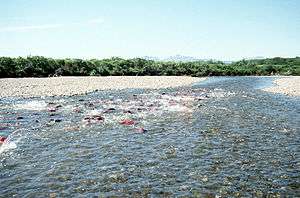
The population of wild salmon declined markedly in recent decades, especially North Atlantic populations, which spawn in the waters of western Europe and eastern Canada, and wild salmon in the Snake and Columbia River systems in northwestern United States.
Salmon population levels are of concern in the Atlantic and in some parts of the Pacific. Alaska fishery stocks are still abundant, and catches have been on the rise in recent decades, after the state initiated limitations in 1972.[79][80] Some of the most important Alaskan salmon sustainable wild fisheries are located near the Kenai River, Copper River, and in Bristol Bay. Fish farming of Pacific salmon is outlawed in the United States Exclusive Economic Zone, however, there is a substantial network of publicly funded hatcheries,[81] and the State of Alaska's fisheries management system is viewed as a leader in the management of wild fish stocks. In Canada, returning Skeena River wild salmon support commercial, subsistence and recreational fisheries, as well as the area's diverse wildlife on the coast and around communities hundreds of miles inland in the watershed. The status of wild salmon in Washington is mixed. Of 435 wild stocks of salmon and steelhead, only 187 of them were classified as healthy; 113 had an unknown status, one was extinct, 12 were in critical condition and 122 were experiencing depressed populations.[82]
The commercial salmon fisheries in California have been either severely curtailed or closed completely in recent years, due to critically low returns on the Klamath and or Sacramento rivers, causing millions of dollars in losses to commercial fishermen.[83] Both Atlantic and Pacific salmon are popular sportfish.
Salmon populations have been established in all the Great Lakes. Coho stocks were planted by the state of Michigan in the late 1960s to control the growing population of non-native alewife. Now Chinook (king), Atlantic, and coho (silver) salmon are annually stocked in all Great Lakes by most bordering states and provinces. These populations are not self-sustaining and do not provide much in the way of a commercial fishery, but have led to the development of a thriving sport fishery.
As food

Salmon is a popular food. Classified as an oily fish,[84] salmon is considered to be healthy due to the fish's high protein, high omega-3 fatty acids, and high vitamin D[85] content. Salmon is also a source of cholesterol, with a range of 23–214 mg/100 g depending on the species.[86] According to reports in the journal Science, farmed salmon may contain high levels of dioxins. PCB (polychlorinated biphenyl) levels may be up to eight times higher in farmed salmon than in wild salmon,[87] but still well below levels considered dangerous.[88][89] Nonetheless, according to a 2006 study published in the Journal of the American Medical Association, the benefits of eating even farmed salmon still outweigh any risks imposed by contaminants.[90] Farmed salmon has a high omega 3 fatty acid content comparable to wild salmon.[91] The type of omega-3 present may not be a factor for other important health functions.
Salmon flesh is generally orange to red, although white-fleshed wild salmon with white-black skin colour occurs. The natural colour of salmon results from carotenoid pigments, largely astaxanthin, but also canthaxanthin, in the flesh.[92] Wild salmon get these carotenoids from eating krill and other tiny shellfish.
The vast majority of Atlantic salmon available around the world are farmed (almost 99%),[93] whereas the majority of Pacific salmon are wild-caught (greater than 80%). Canned salmon in the US is usually wild Pacific catch, though some farmed salmon is available in canned form. Smoked salmon is another popular preparation method, and can either be hot or cold smoked. Lox can refer to either cold-smoked salmon or salmon cured in a brine solution (also called gravlax). Traditional canned salmon includes some skin (which is harmless) and bone (which adds calcium). Skinless and boneless canned salmon is also available.
Raw salmon flesh may contain Anisakis nematodes, marine parasites that cause anisakiasis. Before the availability of refrigeration, the Japanese did not consume raw salmon. Salmon and salmon roe have only recently come into use in making sashimi (raw fish) and sushi.
To the Indigenous peoples of the Pacific Northwest Coast, salmon is considered a vital part of the diet. Specifically, the indigenous peoples of Haida Gwaii, located near former Queen Charlotte Island in British Columbia, rely on salmon as one of their main sources of food, although many other bands have fished Pacific waters for centuries.[94] Salmon are not only ancient and unique, but it is important because it is expressed in culture, art forms, and ceremonial feasts. Annually, salmon spawn in Haida, feeding on everything on the way upstream and down.[94] In Haida, salmon is referred to as "tsiin"[94] There are many forms of preparing it including: smoking, baking, frying, making soup, or candied salmon
Historically, there has always been enough salmon, as people would not overfish, and only took what they needed.[95] In 2003, a report on First Nation participation in commercial fisheries, including salmon, commissioned by BC’s Ministry of Agriculture, Food and Fisheries found that there were 595 First Nation-owned and operated commercial vessels in the province. Of those vessels, First Nations’ members owned 564.[95] However, employment within the industry has decreased overall by 50% in the last decade, with 8,142 registered commercial fishermen in 2003. This has affected employment for many fisherman, who rely on salmon as a source of income.
Black bears also rely on salmon as food. The leftovers the bears leave behind are considered important nutrients for the forest, such as the soil, trees, and plants. In this sense, the salmon feed the forest and in return receive clean water and gravel in which to hatch and grow, sheltered from extremes of temperature and water flow in times of high and low rainfall.[94] However, the condition of the salmon in Haida has been affected in recent decades. Due to logging and development, much of the salmon's habitat (i.e.: Ain River) has been destroyed, resulting in the fish being close to endangered.[94] For residents, this has resulted in limits on catches, in turn, has affected families diets, and cultural events such as feasts. Some of the salmon systems in danger include: the Davidon, Naden, Mamim, and Mathers.[94] It is clear that further protection is needed for salmon, such as their habitats, where logging commonly occurs.
History
.jpg)
The salmon has long been at the heart of the culture and livelihood of coastal dwellers. Many people of the northern Pacific shore had a ceremony to honor the first return of the year. For many centuries, people caught salmon as they swam upriver to spawn. A famous spearfishing site on the Columbia River at Celilo Falls was inundated after great dams were built on the river. The Ainu, of northern Japan, trained dogs to catch salmon as they returned to their breeding grounds en masse. Now, salmon are caught in bays and near shore.
The Columbia River salmon population is now less than 3% of what it was when Lewis and Clark arrived at the river.[96] Salmon canneries established by settlers beginning in 1866 had a strong negative impact on the salmon population. In his 1908 State of the Union address, U.S. President Theodore Roosevelt observed that the fisheries were in significant decline:[97][98]
The salmon fisheries of the Columbia River are now but a fraction of what they were twenty-five years ago, and what they would be now if the United States Government had taken complete charge of them by intervening between Oregon and Washington. During these twenty-five years the fishermen of each State have naturally tried to take all they could get, and the two legislatures have never been able to agree on joint action of any kind adequate in degree for the protection of the fisheries. At the moment the fishing on the Oregon side is practically closed, while there is no limit on the Washington side of any kind, and no one can tell what the courts will decide as to the very statutes under which this action and non-action result. Meanwhile very few salmon reach the spawning grounds, and probably four years hence the fisheries will amount to nothing; and this comes from a struggle between the associated, or gill-net, fishermen on the one hand, and the owners of the fishing wheels up the river.
On the Columbia River the Chief Joseph Dam completed in 1955 completely blocks salmon migration to the upper Columbia River system.
The Fraser River salmon population was affected by the 1914 slide caused by the Canadian Pacific Railway at Hells Gate. The 1917 catch was one quarter of the 1913 catch.[99]
Mythology
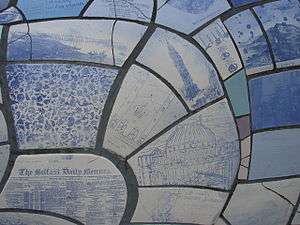
The salmon is an important creature in several strands of Celtic mythology and poetry, which often associated them with wisdom and venerability. In Irish mythology, a creature called the Salmon of Knowledge[100] plays key role in the tale The Boyhood Deeds of Fionn. In the tale, the Salmon will grant powers of knowledge to whoever eats it, and is sought by poet Finn Eces for seven years. Finally Finn Eces catches the fish and gives it to his young pupil, Fionn mac Cumhaill, to prepare it for him. However, Fionn burns his thumb on the salmon's juices, and he instinctively puts it in his mouth. In so doing, he inadvertently gains the Salmon's wisdom. Elsewhere in Irish mythology, the salmon is also one of the incarnations of both Tuan mac Cairill[101] and Fintan mac Bóchra.[102]
Salmon also feature in Welsh mythology. In the prose tale Culhwch and Olwen, the Salmon of Llyn Llyw is the oldest animal in Britain, and the only creature who knows the location of Mabon ap Modron. After speaking to a string of other ancient animals who do not know his whereabouts, King Arthur's men Cai and Bedwyr are led to the Salmon of Llyn Llyw, who lets them ride its back to the walls of Mabon's prison in Gloucester.
In Norse mythology, after Loki tricked the blind god Höðr into killing his brother Baldr, Loki jumped into a river and transformed himself into a salmon to escape punishment from the other gods. When they held out a net to trap him he attempted to leap over it but was caught by Thor who grabbed him by the tail with his hand, and this is why the salmon's tail is tapered.[103]
Salmon are central spiritually and culturally to Native American mythology on the Pacific coast, from the Haida and Coast Salish peoples, to the Nuu-chah-nulth peoples in British Columbia.[104]
References
- 1 2 3 4 Based on data sourced from the relevant FAO Species Fact Sheets
- ↑ "NOAA/NMFS/NWFSC-TM30: Homing, Straying, and Colonization". Nwfsc.noaa.gov. Retrieved 11 August 2015.
- ↑ Scholz AT, Horrall RM, Cooper JC, Hasler AD (1976). "Imprinting to chemical cues: The basis for home stream selection in salmon". Science. 192 (4245): 1247–9. PMID 1273590.
- ↑ Ueda H (2011). "Physiological mechanism of homing migration in Pacific salmon from behavioral to molecular biological approaches". General and Comparative Endocrinology. 170 (2): 222–32. doi:10.1016/j.ygcen.2010.02.003. PMID 20144612.
- ↑ Salmon etymonline.com, Online Etymology Dictionary. Retrieved 25 April 2012.
- ↑ Heiko Schneider (25 August 2011). "Patagonian salmonids-This is the history and present state of salmonid introduction in Patagonia". Global Fly Fisher. Retrieved 25 April 2014.
- ↑ Froese, Rainer and Pauly, Daniel, eds. (2012). "Salmo salar" in FishBase. April 2012 version.
- 1 2 Salmo salar, Linnaeus, 1758 FAO, Species Fact Sheet. Retrieved April 2012.
- ↑ "Salmo salar". Integrated Taxonomic Information System.
- ↑ World Conservation Monitoring Centre (1996). "Salmo salar". IUCN Red List of Threatened Species. Version 2011.2. International Union for Conservation of Nature.
- ↑ Froese, Rainer and Pauly, Daniel, eds. (2012). "Oncorhynchus tshawytscha" in FishBase. April 2012 version.
- ↑ Oncorhynchus tshawytscha (Walbaum, 1792) FAO, Species Fact Sheet. Retrieved April 2012.
- ↑ "Oncorhynchus tshawytscha". Integrated Taxonomic Information System.
- ↑ Froese, Rainer and Pauly, Daniel, eds. (2012). "Oncorhynchus keta" in FishBase. April 2012 version.
- ↑ Oncorhynchus keta (Walbaum, 1792) FAO, Species Fact Sheet. Retrieved April 2012.
- ↑ "Oncorhynchus keta". Integrated Taxonomic Information System.
- ↑ Froese, Rainer and Pauly, Daniel, eds. (2012). "Oncorhynchus kisutch" in FishBase. April 2012 version.
- ↑ Oncorhynchus kisutch (Walbaum, 1792) FAO, Species Fact Sheet. Retrieved April 2012.
- ↑ "Oncorhynchus kisutch". Integrated Taxonomic Information System.
- ↑ Froese, Rainer and Pauly, Daniel, eds. (2012). "Oncorhynchus masou" in FishBase. April 2012 version.
- ↑ "Oncorhynchus masou". Integrated Taxonomic Information System.
- ↑ Froese, Rainer and Pauly, Daniel, eds. (2012). "Oncorhynchus gorbuscha" in FishBase. April 2012 version.
- ↑ Oncorhynchus gorbuscha (Walbaum, 1792) FAO, Species Fact Sheet. Retrieved April 2012.
- ↑ "Oncorhynchus gorbuscha". Integrated Taxonomic Information System.
- ↑ Froese, Rainer and Pauly, Daniel, eds. (2012). "Oncorhynchus nerka" in FishBase. April 2012 version.
- ↑ Oncorhynchus nerka (Walbaum, 1792) FAO, Species Fact Sheet. Retrieved April 2012.
- ↑ "Oncorhynchus nerka". Integrated Taxonomic Information System.
- ↑ Rand PS (2011). "Salmo salar". IUCN Red List of Threatened Species. Version 2011.2. International Union for Conservation of Nature.
- ↑ Froese, Rainer and Pauly, Daniel, eds. (2012). "Arripis trutta" in FishBase. April 2012 version.
- ↑ "Arripis trutta". Integrated Taxonomic Information System.
- ↑ Froese, Rainer and Pauly, Daniel, eds. (2012). "Hucho hucho" in FishBase. April 2012 version.
- ↑ "Hucho hucho". Integrated Taxonomic Information System.
- ↑ Freyhof J & Kottelat M (2008). "Hucho hucho". IUCN Red List of Threatened Species. Version 2011.2. International Union for Conservation of Nature.
- ↑ Froese, Rainer and Pauly, Daniel, eds. (2012). "Elagatis bipinnulata" in FishBase. April 2012 version.
- ↑ Elagatis bipinnulata (Quoy & Gaimard, 1825) FAO, Species Fact Sheet. Retrieved April 2012.
- ↑ "Elagatis bipinnulata". Integrated Taxonomic Information System.
- ↑ Froese, Rainer and Pauly, Daniel, eds. (2012). "Eleutheronema tetradactylum" in FishBase. April 2012 version.
- ↑ "Eleutheronema tetradactylum". Integrated Taxonomic Information System.
- ↑ Montgomery, David. King Of Fish Cambridge, MA: Westview Press, 2004. 27.28. Print.
- ↑ "Chinook Salmon". Alaska Department of Fish and Game. Retrieved 17 November 2006.
- 1 2 3 Stephenson, S. A. "The Distribution of Pacific Salmon (''Oncorhynchus'' spp.) in the Canadian Western Arctic" (PDF). Retrieved 1 September 2013.
- ↑ "Chinook Salmon". NOAA Fisheries. 6 April 2012. Archived from the original on 28 May 2012.
- ↑ "Chum Salmon". Alaska Department of Fish and Game. Retrieved 17 November 2006.
- ↑ "Coho Salmon". NOAA Fisheries. 28 June 2012. Archived from the original on 2 February 2013.
- ↑ "Formosan salmon". Taiwan Journal. Retrieved 13 December 2006.
- ↑ "Pink Salmon". Alaska Department of Fish and Game. Retrieved 17 November 2006.
- ↑ "Sockeye Salmon". Alaska Department of Fish and Game. Retrieved 17 November 2006.
- 1 2 3 "Pacific Salmon, (Oncorhynchus spp.)". U.S. Fish and Wildlife Services. Retrieved 17 November 2006.
- ↑ "A Salmon's Life: An Incredible Journey". U.S. Bureau of Land Management. Archived from the original on 25 February 2009.
- ↑ McGrath, Susan. "Spawning Hope". Audubon Society. Retrieved 17 November 2006.
- ↑ Willson MF & Halupka KC (1995). "Anadromous Fish as Keystone Species in Vertebrate Communities" (PDF). Conservation Biology. 9 (3): 489–497. doi:10.1046/j.1523-1739.1995.09030489.x. JSTOR 2386604.
- ↑ Reimchen TE (2001). "Salmon nutrients, nitrogen isotopes and coastal forests" (PDF). Ecoforestry. 16: 13.
- ↑ Quinn, T.; Carlson, S.; Gende, S. & Rich, H. (2009). "Transportation of Pacific Salmon Carcasses from Streams to Riparian Forests by Bears" (PDF). Canadian Journal of Zoology. 87 (3): 195–203. doi:10.1139/Z09-004.
- ↑ Reimchen TE, Mathewson DD, Hocking MD & Moran J (2002). "Isotopic evidence for enrichment of salmon-derived nutrients in vegetation, soil, and insects in riparian zones in coastal British Columbia" (PDF). American Fisheries Society Symposium. 20: 1–12.
- ↑ Helfield, J. & Naiman, R. (2006). "Keystone Interactions: Salmon and Bear in Riparian Forests of Alaska" (PDF). Ecosystems. 9 (2): 167–180. doi:10.1007/s10021-004-0063-5.
- ↑ Northwest Power & Conservation Council. "Extinction". Retrieved 21 December 2007.
- ↑ Hyatt, K D; McQueen, D J; Shortreed, K S; Rankin, D P (2004). "Sockeye salmon (Oncorhynchus nerka) nursery lake fertilization: Review and summary of results". Environmental Reviews. 12 (3): 133. doi:10.1139/a04-008.
- ↑ Pollock, M. M.; Pess, G. R. & Beechie, T. J. "The Importance of Beaver Ponds to Coho Salmon Production in the Stillaguamish River Basin, Washington, USA" (PDF). Retrieved 21 December 2007.
- ↑ Gregory Hood, W. "AN OVERLOOKED ECOLOGICAL WEB". Archived from the original on 24 July 2008.
- ↑ Crosier, Danielle M.; Molloy, Daniel P.; Bartholomew, Jerri. "Whirling Disease – Myxobolus cerebralis" (PDF). Retrieved 13 December 2007.
- ↑ Boyce, N.P.; Kabata, Z.; Margolis, L. (1985). "Investigation of the Distribution, Detection, and Biology of Henneguya salminicola (Protozoa, Myxozoa), a Parasite of the Flesh of Pacific Salmon". Canadian Technical Report of Fisheries and Aquatic Sciences (1450): 55.
- ↑ Sea Lice and Salmon: Elevating the dialogue on the farmed-wild salmon story Watershed Watch Salmon Society, 2004
- ↑ Bravo, S. (2003). "Sea lice in Chilean salmon farms". Bull. Eur. Assoc. Fish Pathol. 23: 197–200.
- ↑ Morton, A.; R. Routledge; C. Peet & A. Ladwig (2004). "Sea lice (Lepeophtheirus salmonis) infection rates on juvenile pink (Oncorhynchus gorbuscha) and chum (Oncorhynchus keta) salmon in the nearshore marine environment of British Columbia, Canada". Canadian Journal of Fisheries and Aquatic Sciences. 61 (2): 147. doi:10.1139/f04-016.
- ↑ Peet, C. R. (2007). Interactions between sea lice (Lepeophtheirus salmonis and Caligus clemensii), juvenile salmon (Oncorhynchus keta and Oncorhynchus gorbuscha) and salmon farms in British Columbia. M.Sc. Thesis, University of Victoria, Victoria, British Columbia, Canada.
- ↑ Krkošek, M.; A. Gottesfeld; B. Proctor; D. Rolston; C. Carr-Harris; M.A. Lewis (2007). "Effects of host migration, diversity and aquaculture on sea lice threats to Pacific salmon populations". Proceedings of the Royal Society B: Biological Sciences. 274 (1629): 3141–9. doi:10.1098/rspb.2007.1122. PMC 2293942
 . PMID 17939989.
. PMID 17939989. - ↑ Morton, A.; R. Routledge; M. Krkošek (2008). "Sea Louse Infestation in Wild Juvenile Salmon and Pacific Herring Associated with Fish Farms off the East-Central Coast of Vancouver Island, British Columbia" (PDF). North American Journal of Fisheries Management. 28 (2): 523. doi:10.1577/M07-042.1.
- ↑ Krkošek, M.; M.A. Lewis; A. Morton; L.N. Frazer; J.P. Volpe (2006). "Epizootics of wild fish induced by farm fish". Proceedings of the National Academy of Sciences. 103 (42): 15506. doi:10.1073/pnas.0603525103.
- ↑ Krkošek, Martin (2007). "Declining Wild Salmon Populations in Relation to Parasites from Farm Salmon". Science. 318 (5857): 1772–5. doi:10.1126/science.1148744. PMID 18079401.
- ↑ Weissglas G and Appelblad H (1997) "Wild-spawning Baltic salmon – A natural resource redefined: From food to toys for "boys"? In: A-L Toivonen and Tuunainen P (Eds) Socio-economics of recreational fishery, pp. 89–95, Nordic Council of Ministers. ISBN 9789289301206.
- 1 2 Shaw, Susan and Muir, James F. (1987) Salmon: Economics and Marketing Page 250, Springer. ISBN 9780709933441.
- ↑ Seafood Choices Alliance (2005) It's all about salmon
- ↑ Wright, Matt. "Fish farms drive wild salmon populations toward extinction", EurekAlert, 13 December 2007.
- ↑ Naylor, Rosamond L. "Nature's Subsidies to Shrimp and Salmon Farming" (PDF). Science; 10/30/98, Vol. 282 Issue 5390, p883.
- ↑ "Pigments in Salmon Aquaculture: How to Grow a Salmon-colored Salmon". Retrieved 26 August 2007.
Astaxanthin (3,3'-hydroxy-β,β-carotene-4,4'-dione) is a carotenoid pigment, one of a large group of organic molecules related to vitamins and widely found in plants. In addition to providing red, orange, and yellow colours to various plant parts and playing a role in photosynthesis, carotenoids are powerful antioxidants, and some (notably various forms of carotene) are essential precursors to vitamin A synthesis in animals.
- ↑ Guilford, Gwynn (12 March 2015). "Here's why your farmed salmon has color added to it". Quartz (publication). Retrieved 12 March 2015.
- 1 2 Rust, Michael B. et al. (November 2010) The Future of Aquafeeds. aquaculture.noaa.gov. p. 56.
- ↑ Salmon Recovery Planning. nwr.noaa.gov. p. 57.
- ↑ "1878–2010, Historical Commercial Salmon Catches and Exvessel Values". Alaska Department of Fish and Game. Retrieved 6 August 2011.
- ↑ Viechnicki, Joe (3 August 2011). "Pink salmon numbers record setting in early season". KRBD Public Radio in Ketchikan, Alaska. Retrieved 6 August 2011.
- ↑ media.aprn.org|low fish returns in Southeast this summer have been tough on the region's hatcheries
- ↑ Johnson, Thom H.; Lincoln, Rich; Graves, Gary R. & Gibbons, Robert G. "Status of Wild Salmon and Steelhead Stocks in Washington State". In Stouder, Deanna J.; Bisson, Peter A. & Naiman, Robert J. Pacific Salmon and Their Ecosystems: Status and Future Options. Springer. pp. 127–144. doi:10.1007/978-1-4615-6375-4_11. ISBN 978-1-4615-6375-4.
- ↑ Hackett, S. & D. Hansen. "Cost and Revenue Characteristics of the Salmon Fisheries in California and Oregon". Retrieved 1 June 2009.
- ↑ "What's an oily fish?". Food Standards Agency. 24 June 2004. Archived from the original on 19 October 2014.
- ↑ "Dietary Supplement Fact Sheet: Vitamin D". National Institutes of Health. Archived from the original on 13 December 2007. Retrieved 13 December 2007.
- ↑ "Cholesterol: Cholesterol Content in Seafoods (Tuna, Salmon, Shrimp)". Retrieved 13 December 2007.
- ↑ Hites, R. A.; Foran, J. A.; Carpenter, D. O.; Hamilton, M. C.; Knuth, B. A.; Schwager, S. J. (2004). "Global Assessment of Organic Contaminants in Farmed Salmon". Science. 303 (5655): 226–9. doi:10.1126/science.1091447. PMID 14716013.
- ↑ "Farmed vs. wild salmon – which is better?". CTV News. Retrieved 28 April 2013.
- ↑ Foran, J. A.; Carpenter, D. O.; Hamilton, M. C.; Knuth, B. A.; Schwager, S. J. (2005). "Risk-Based Consumption Advice for Farmed Atlantic and Wild Pacific Salmon Contaminated with Dioxins and Dioxin-like Compounds". Environmental Health Perspectives. 113 (5): 552–556. doi:10.1289/ehp.7626. PMC 1257546
 .
. - ↑ Mozaffarian, Dariush; Rimm, Eric B. (2006). "Fish Intake, Contaminants, and Human Health". JAMA. 296 (15): 1885. doi:10.1001/jama.296.15.1885. PMID 17047219.
- ↑ Raatz, S. K.; Rosenberger, T. A.; Johnson, L. K.; Wolters, W. W.; Burr, G. S.; Picklo Mj, Sr (2013). "Dose-Dependent Consumption of Farmed Atlantic Salmon (Salmo salar) Increases Plasma Phospholipid n-3 Fatty Acids Differentially". Journal of the Academy of Nutrition and Dietetics. 113 (2): 282–7. doi:10.1016/j.jand.2012.09.022. PMC 3572904
 . PMID 23351633.
. PMID 23351633. - ↑ "Opinion of the Scientific Committee on Animal Nutrition on the use of canthaxanthin in feedingstuffs for salmon and trout, laying hens, and other poultry." (PDF). European Commission — Health & Consumer Protection Directorate. pp. 6–7. Retrieved 13 November 2006.
- ↑ Montaigne, Fen. "Everybody Loves Atlantic Salmon: Here's the Catch...". National Geographic. Retrieved 17 November 2006.
- 1 2 3 4 5 6 Haida Gwaii Strategic Land Use Agreement. haidanation.ca (September 2007)
- 1 2 Garner, Kerri and Parfitt, Ben (April 2006) First Nations, Salmon Fisheries and the Rising Importance of Conservation. Vancouver, BC: Prepared for the Pacific Fisheries Resource Conservation Council. ISBN 1-897110-28-6
- ↑ "Endangered Salmon". U.S. Congressman Jim McDermott. Archived from the original on 15 November 2006. Retrieved 17 November 2006.
- ↑ "Columbia River History: Commercial Fishing". Northwest Power and Conservation Council. 2010. Retrieved 26 January 2012.
- ↑ Roosevelt, Theodore (8 December 1908). "State of the Union Address Part II by Theodore Roosevelt". Retrieved 31 January 2012.
- ↑ Babcock, John P. (1920). Fraser River Salmon Situation a Reclamation Project. Victoria, B.C.: W. H. Cullin. p. 5
- ↑ "The Salmon of Knowledge. Celtic Mythology, Fairy Tale". Luminarium.org. 18 January 2007. Retrieved 1 June 2010.
- ↑ "The Story of Tuan mac Cairill". Maryjones.us. Retrieved 18 March 2010.
- ↑ "The Colloquy between Fintan and the Hawk of Achill". Ucc.ie. Retrieved 18 March 2010.
- ↑ "The Poetic Edda,". Translated by Henry Adams Bellows. Retrieved 27 April 2011.
- ↑ Salmon Culture of the Pacific Northwest Tribes. Columbia River Inter-Tribal Fish Commission
Further reading
- Atlas of Pacific Salmon, Xanthippe Augerot and the State of the Salmon Consortium, University of California Press, 2005, hardcover, 152 pages, ISBN 0-520-24504-0
- Making Salmon: An Environmental History of the Northwest Fisheries Crisis, Joseph E. Taylor III, University of Washington Press, 1999, 488 pages, ISBN 0-295-98114-8
- Trout and Salmon of North America, Robert J. Behnke, Illustrated by Joseph R. Tomelleri, The Free Press, 2002, hardcover, 359 pages, ISBN 0-7432-2220-2
- Come back, salmon, By Molly Cone, Sierra Club Books, 48 pages, ISBN 0-87156-572-2 – A book for juveniles describes the restoration of 'Pigeon Creek'.
- The salmon: their fight for survival, By Anthony Netboy, 1973, Houghton Mifflin Co., 613 pages, ISBN 0-395-14013-7
- A River Lost, by Blaine Harden, 1996, WW Norton Co., 255 pages, ISBN 0-393-31690-4. (Historical view of the Columbia River system).
- River of Life, Channel of Death, by Keith C. Peterson, 1995, Confluence Press, 306 pages, ISBN 978-0-87071-496-2. (Fish and dams on the Lower Snake River.)
- Salmon, by Dr Peter Coates, 2006, ISBN 1-86189-295-0
- Lackey, Robert T (2000) "Restoring Wild Salmon to the Pacific Northwest: Chasing an Illusion?" In: Patricia Koss and Mike Katz (Eds) What we don't know about Pacific Northwest fish runs: An inquiry into decision-making under uncertainty, Portland State University, Portland, Oregon. Pages 91–143.
- Mills D (2001) "Salmonids" In: pp. 252–261, Steele JH, Thorpe SA and Turekian KK (2010) Marine Biology: A Derivative of the Encyclopedia of Ocean Sciences, Academic Press. ISBN 978-0-08-096480-5.
- NEWS January 31, 2007: U.S. Orders Modification of Klamath River – Dams Removal May Prove More Cost-Effective for allowing the passage of Salmon
- Salmon age and sex composition and mean lengths for the Yukon River area, 2004 / by Shawna Karpovich and Larry DuBois. Hosted by Alaska State Publications Program.
 "Studies in the Natural History of the Sacramento Salmon". Popular Science Monthly. 61. July 1902.
"Studies in the Natural History of the Sacramento Salmon". Popular Science Monthly. 61. July 1902.- Trading Tails: Linkages Between Russian Salmon Fisheries and East Asian Markets. Shelley Clarke. (November 2007). 120pp. ISBN 978-1-85850-230-4.
- The Salmons Tale one of the twelve Ionan Tales by Jim MacCool
External links
| Wikimedia Commons has media related to Salmonidae. |
| Wikiquote has quotations related to: Salmon |
| Wikisource has the text of the 1905 New International Encyclopedia article Salmon. |
- "Last Stand of the American Salmon," G. Bruce Knecht for Men's Journal
- Plea for the Wanderer, an NFB documentary on West Coast salmon
- Genetic Status of Atlantic Salmon in Maine: Interim Report (2002) Online book
- Arctic Salmon on Facebook research project studying Pacific salmon in the Arctic and potential links to climate change
- University of Washington Libraries Digital Collections – Salmon Collection A collection of documents describing salmon of the Pacific Northwest.
- Salmon Nation A movement to create a bioregional community, based on the historic spawning area of Pacific salmon (CA to AK).
- Arctic Salmon Pacific salmon distribution and abundance seems to be increasing in the Arctic. Links to a Canadian research project documenting changes in Pacific salmon and studying Pacific salmon ecology in the Arctic.

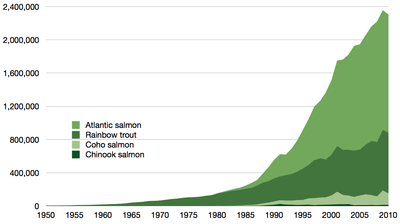
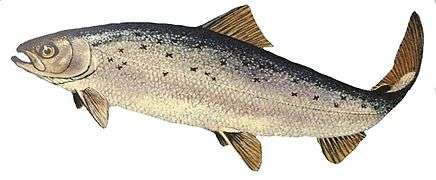
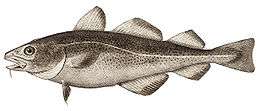
.png)
